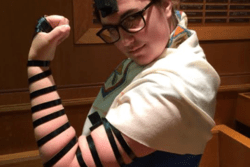The Gendered Dimensions of Choosing to Wear a Kippah
My early years were marked by a typical case of “girliness”: an obsession with princesses, fairies, gauzy dresses, and whatever else my kindergarten self perceived as peak femininity. Yet by the time I hit elementary school I had swung the other direction into “not like other girls” territory, passionately rejecting anything even remotely feminine. I dressed in plain, dark shirts from Lands’ End and Old Navy, gray New Balance sneakers, and wore my hair in two messy braids day in and out. I felt physically uncomfortable, like my skin was crawling, if I had to wear anything from my list of forbidden accessories: bows, buttons, sequins, sparkles, ruffles, or any pattern besides plain stripes.
As I aged into middle school, I began to realize that I did actually enjoy feminine gender expression, as long as it aligned with my own laid-back personal style. It wasn’t that I didn’t connect with femininity, but that eleven-year-old me had internalized the message that femininity meant vapidity, immaturity, and self-absorption. I began to feel just as uncomfortable in my baggy jeans as I had once felt in pink dresses. Layered onto this was the excruciating awareness of just how much my gender presentation did not fit into what a seventh grade girl was “supposed” to look like, making me feel agonizingly out of place in a world of Brandy Melville tops and Target bralettes.
I slowly began my return to femininity, though I was still self-conscious about seeming as though I was embracing those “feminine” characteristics of trendiness and vanity. By high school though, I had found a comfortable gender expression for myself: clearly feminine and also clearly me.
While these experiences of rejecting and reclaiming femininity are fairly common, my story of gender expression came with a parallel plot thread: my religious expression. At my Reform Jewish Sunday school, nearly all the students wore kippot regardless of gender during our youth services, and I too enjoyed the feeling of clipping a colorful kippah to my hair. I was aware that kippot were traditionally a male-only item (and were sometimes even excluded from Reform spaces altogether), but in my egalitarian congregation it felt affirming and modern for us all to wear kippot if we chose. True, during services with the entire congregation, only a few women wore kippot (and even fewer wore tallitot), but I saw that as the dregs of an outdated tradition. I cherished being the first woman in my family to wear a tallit at my bat mitzvah, feeling proud to move past the legacy of sexism in Judaism.
Yet as I entered high school—my era of comfortable femininity and conscious feminism—I found myself increasingly uncomfortable with wearing kippot. It gave me that same itchy, wrong feeling I had experienced from feminine clothing in elementary school or masculine clothing in middle school. It wasn’t a religious gripe—I still love kippot on a conceptual level, the way they manifest Jewishness on our bodies and express reverence before God (major Jewish anarchism vibes), and I even love how much you can tell about someone’s Jewish background by what kind of kippah they wear.
So why did I feel so uncomfortable wearing a kippah, especially after years of happily doing so? Truthfully, it made me feel too masculine. Even though theologically, I believed kippot should be a gender-neutral item, I couldn’t deny the reality that relatively few women wore them. Just as we internalize so many other symbols of gender expression from the culture around us, I internalized kippot as a quintessential symbol of Jewish masculinity. I feel a rush of affection when I see a man wearing a kippah, reminding me of so many cousins, friends, and campmates whom I love in all their NJB mishegas. On the other hand, a woman wearing a kippah reminds me only of the few female rabbis or other active Jewish feminists I know who wear a kippah on a regular basis. Regardless of their actual intentions, I have to admit I still perceive this as the intentional adoption of a male symbol to make a statement, rather than an actually gender-neutral or even potentially feminine practice.
As I have reflected on these internalized beliefs, I realize that I was most likely never truly comfortable with kippot themselves. Rather, I was comfortable with masculinity at the time, and so wearing something I understood as masculine didn’t bother me. Today, even as I acknowledge that gender is a social construct and nothing is objectively masculine or feminine, my sense of femininity makes me uncomfortable with kippot. Every time I am faced with the option to wear one, I feel the tension between my desire for comfortable gender expression and my desire to engage in a religious practice I find meaningful.
Frankly, I do not know what the path forward is here. Am I obligated to prevent the perpetuation of kippot’s masculinity by pushing through my discomfort and wearing a kippah myself? Is there a way for me to unlearn my association of kippot and masculinity, or even to find an authentically “feminine” way of wearing a kippah? Is it inherently harmful for mitzvot to be gendered, or can this actually make space for the expansiveness of human gender? I do not know, and I certainly cannot answer these questions alone.
I’ve always been struck by the parallels between my Jewishness and womanhood. Both are socially constructed identities which nevertheless feel inherent to my existence; both are hard to objectively define but shape so much of my life nonetheless. They feel almost mystical, experiences which cannot be described by reason or logic alone.
Jewish feminism asks us not to turn away from these ambiguities, but to keep wrestling with our personal and collective experiences. As both my gender and religious identities continue to evolve, I don’t know where my feelings about kippot will settle—but I will lean into the tension, making my own choices with the complexity of our tradition.
This piece was written as part of JWA’s Rising Voices Fellowship.







